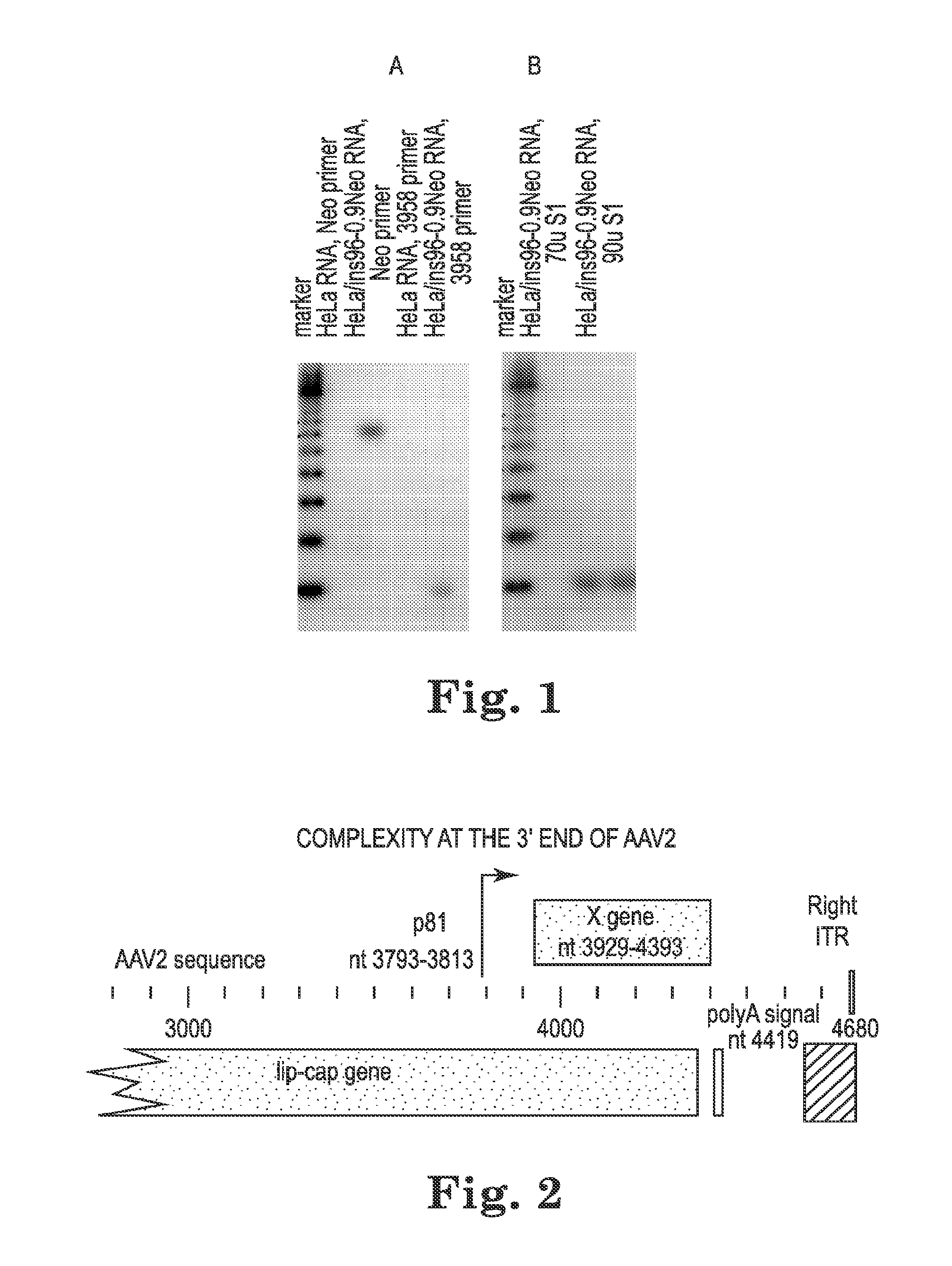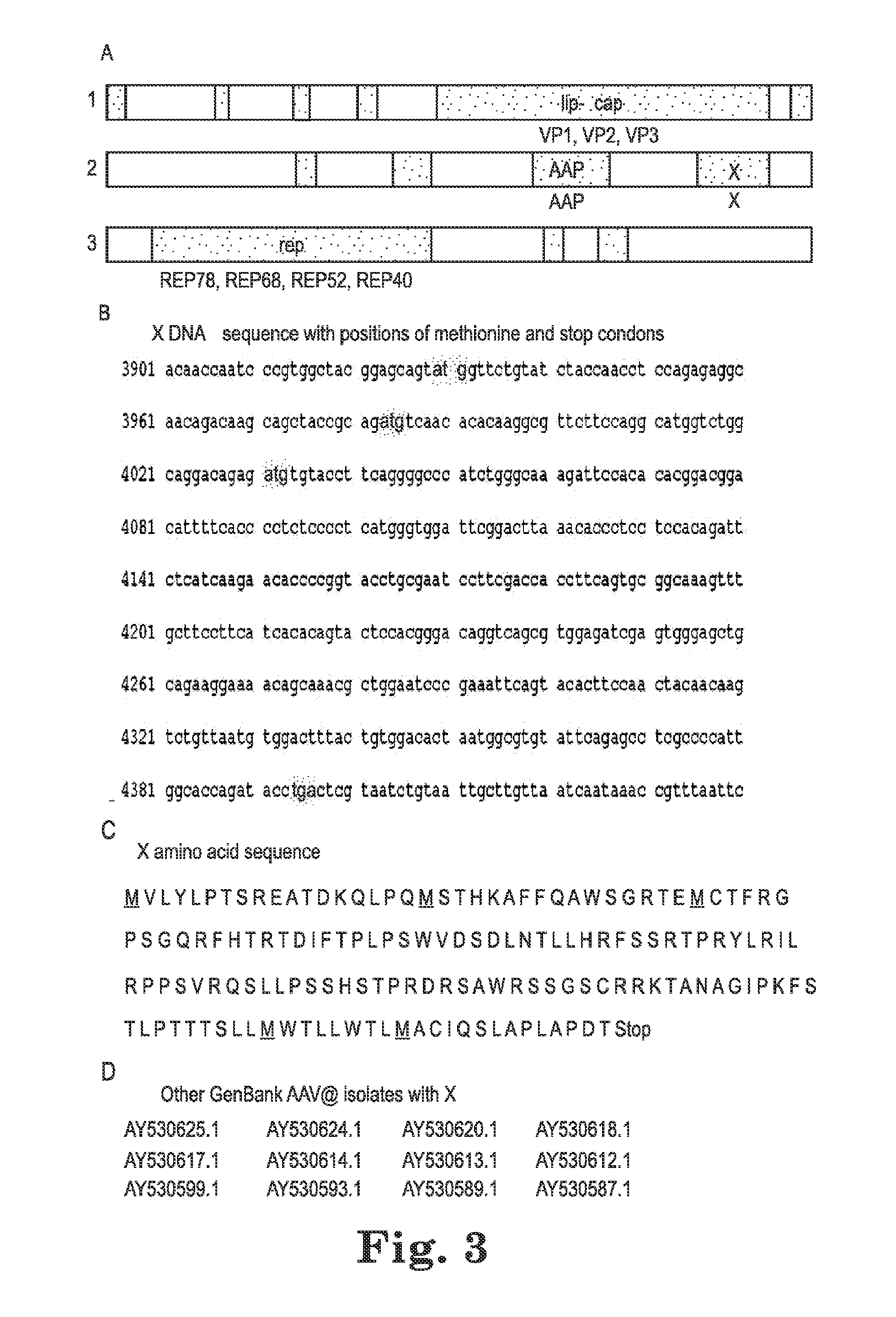Adeno-associated virus "x" oncogene
a technology of adenovirus and oncogene, which is applied in the field of adenovirus " x " oncogene, can solve problems such as human health risk in gene therapy, and achieve the effects of improving efficiency and yield, and promoting aav replication
- Summary
- Abstract
- Description
- Claims
- Application Information
AI Technical Summary
Benefits of technology
Problems solved by technology
Method used
Image
Examples
example 1
Identification of p81 Promoter in Adeno-Associated Virus Type 2 (AAV2) p81 Promoter and Hypothetical Open Reading Frame “X”
p81 Promoter
[0056]We identified a previously unknown promoter in the Lip-Cap gene in AAV2 at nt 3793-3813. HeLa cells were transduced with the Ins96-0.9Neo AAV. Ins96 is a genetically and phenotypically wild-type AAV genome (Hermonat, P L et al., 1984, Proc. Natl. Acad. Sci. USA 81:6466-6470). To create Ins96-0.9Neo, the 960-base neo gene was ligated into the BglII sit at nt 4483 if Ins96. Expression at the 3′ end of the AAV gene was studied by reverse transcriptase primer extension (RT-PE). One primer was homologous to the Neo sequences and the other to a sequence ending at nt 3958. FIG. 1A shows that primer extension with the nt 3958 primer produced an extension product approximately 100 nt long. FIG. 5B shows an S1 nuclease protection assay using an antisense DNA protector which was generated using the 3958 primer. The S1-protected product in B is the same si...
example 2
AAV “X” Promotes AAV Replication and Efficient Generation of Recombinant AAV
[0058]In this Example, we investigated whether the open reading frame “X” described in Example 1 is actually expressed as a protein, and what the function of the protein might be.
Results.
Computer Analysis and Generation of X Reagents.
[0059]X is a rather significant ORF of 465 base pairs, 155 amino acids. FIG. 3A, shows a cartoon of the AAV2 genome and includes the relative position of genes / open reading frames (ORF). FIG. 3B shows the DNA sequence of the AAV2 X ORF derived from NCBI Reference Sequence NC_001401.2, and FIG. 3C shows the corresponding amino acid sequence derived from the X ORF. FIG. 3D shows other sequences of AAV2 isolates that also contain the X ORF. We analyzed whether we might be able to identify an actual X protein. FIG. 4 shows a western blot of protein from Ad5-infected 293 cells, with pSM620 (wt AAV2) co-transfected with AAV / Neo or AAV / X / Neo, which identifies an enhanced protein band a...
example 3
AAV “X” is an Oncogene
[0078]In cell transfection experiments we noticed that the transfection of “X”-expressing plasmid caused the medium of cells to become yellow (acid pH, higher metabolic activity) before that of control plates. Thus we considered that “X” may be a possible oncogene or pro-growth gene. We found AAV2 “X” has homology to HTLV2 Tax, a known oncogene (49-51), and to cellular INO80, a protein involved in chromatin remodeling (44-48) and known to bind p53 (45). So we tested “X” for oncogenic transformation abilities in contact inhibited swiss albino 3T3 cells.
Results
Introduction of X Causes Focus Formation in Contact-Inhibited Swiss Albino 3T3 Cells (SA3T3)
[0079]While the function of X is unverified, one possible function might be that of a progrowth gene, possibly even an oncogene, as all other small DNA viruses encode at least one such gene. To test this hypothesis initially we infected several contact inhibited rodent fibroblast cell lines and found little evidence ...
PUM
| Property | Measurement | Unit |
|---|---|---|
| pH | aaaaa | aaaaa |
| diameter | aaaaa | aaaaa |
| therapeutic composition | aaaaa | aaaaa |
Abstract
Description
Claims
Application Information
 Login to View More
Login to View More - R&D
- Intellectual Property
- Life Sciences
- Materials
- Tech Scout
- Unparalleled Data Quality
- Higher Quality Content
- 60% Fewer Hallucinations
Browse by: Latest US Patents, China's latest patents, Technical Efficacy Thesaurus, Application Domain, Technology Topic, Popular Technical Reports.
© 2025 PatSnap. All rights reserved.Legal|Privacy policy|Modern Slavery Act Transparency Statement|Sitemap|About US| Contact US: help@patsnap.com



